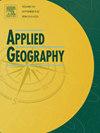From path creation to path transformation: the geography of new energy vehicle production in China
IF 4
2区 地球科学
Q1 GEOGRAPHY
引用次数: 0
Abstract
Although the new energy vehicle (NEV) industry is providing new impetus for China's regional development, a deeper understanding of its conditions and processes remains imperative. This study extends path creation theory from evolutionary economic geography to explore the enabling environment for both path creation and subsequent path development. Challenging the conventional thinking that view the emergence industry as a new path, this study posits that the NEV sector's development is shaped by the dynamic interplay of multiple paths, including the headquarter, three-power, and vehicle assembly path. The inter-path interactions drive the industry transform through different development phases. Accordingly, this study proposes a framework comprising three-phase path transformation (selection, competition, and integration) and five-component enabling environment (strategic resources, industrial base, innovation environment, market competition, and institutional support). Empirical results, based on the Lotka-Volterra model and fixed effects models, show that: (1) enabling environment for path transformation varies across paths and phases; (2) while industrial base initiate path selection, its influence diminishes in later transformation phases; (3) vehicle assembly path exhibits dual technology-push and market-pull characteristics, while three-power path is policy-driven and subject to strategic resources. This finding suggests challenges for endogenous path development, as subsidies are phased out from 2023 onwards.
从路径创造到路径转型:中国新能源汽车生产的地理格局
尽管新能源汽车(NEV)行业正在为中国的区域发展提供新的动力,但对其条件和过程的更深入了解仍然是必要的。本研究延伸演化经济地理学的路径创造理论,探讨路径创造与后续路径发展的有利环境。本研究挑战了将新兴产业视为新路径的传统思维,认为新能源汽车行业的发展是由总部路径、三动力路径和整车组装路径等多种路径的动态相互作用形成的。路径间的相互作用推动着产业在不同发展阶段的转型。据此,本研究提出了一个由三阶段路径转换(选择、竞争和整合)和五要素赋能环境(战略资源、产业基础、创新环境、市场竞争和制度支持)组成的框架。基于Lotka-Volterra模型和固定效应模型的实证结果表明:(1)路径转换的有利环境在不同路径和阶段存在差异;(2)产业基地对路径选择的主导作用在转型后期逐渐减弱;(3)整车装配路径表现出技术推动和市场拉动的双重特征,而三动力路径则表现为政策驱动和战略资源驱动。这一发现表明,随着补贴从2023年起逐步取消,内生路径发展面临挑战。
本文章由计算机程序翻译,如有差异,请以英文原文为准。
求助全文
约1分钟内获得全文
求助全文
来源期刊

Applied Geography
GEOGRAPHY-
CiteScore
8.00
自引率
2.00%
发文量
134
期刊介绍:
Applied Geography is a journal devoted to the publication of research which utilizes geographic approaches (human, physical, nature-society and GIScience) to resolve human problems that have a spatial dimension. These problems may be related to the assessment, management and allocation of the world physical and/or human resources. The underlying rationale of the journal is that only through a clear understanding of the relevant societal, physical, and coupled natural-humans systems can we resolve such problems. Papers are invited on any theme involving the application of geographical theory and methodology in the resolution of human problems.
 求助内容:
求助内容: 应助结果提醒方式:
应助结果提醒方式:


